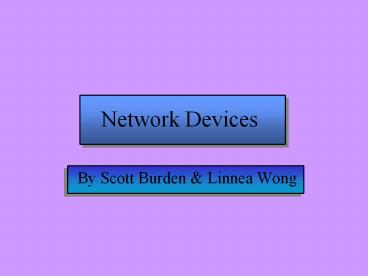Network Devices - PowerPoint PPT Presentation
1 / 9
Title:
Network Devices
Description:
Network Devices By Scott Burden & Linnea Wong Hubs Intelligent hubs have console ports, to allow monitoring of the hubs status and port activity. – PowerPoint PPT presentation
Number of Views:121
Avg rating:3.0/5.0
Title: Network Devices
1
Network Devices
- By Scott Burden Linnea Wong
2
Hubs
- Intelligent hubs have console ports, to allow
monitoring of the hubs status and port activity. - Passive hubs just repeat any incoming signals to
every port available, therefore does not act as a
line repeater. - Passive hubs just split signals to multiple ports
but do not regenerate the signals, which means
that they do not extend a cables length. They
only allow two or more hosts to connect to the
same cable segment. - Active hubs regenerate signals.
- Hubs utilise star topology.
3
Hub Pros Cons
- Advantages
- As an active hubs regenerate signals, it
increases the distance that can be spanned by the
LAN (up to 100 meters per segment). - Hubs can also be connected locally to a maximum
of two other hubs, thereby increasing the number
of devices that can be attached to the LAN. - Active hubs are usually used against attenuation,
which is a decrease in the strength of the signal
over distance.
- Disadvantages
- Bandwidth is shared by all hosts i.e. 10Mbs
shared by 25 ports/users. - Can create bottlenecks when used with switches.
- Have no layer 3 switching capability.
- Most Hubs are unable to utilise VLANS.
4
Switches
- A switch is a multi-port bridge.
- It operates at OSI data link layer 2.
- It stores MAC addresses in an internal lookup
table. - Temporary switched paths are created between the
frames source destination. - Some Switches have limited layer 3 IP routing
capabilities. - Switches can be configured to use VLANS.
- Switches support spanning tree protocol to create
resilient networks.
5
Example Topology
6
Transceiver Modules
- Connects to any Auxiliary Unit Interface port
(AUI). - Operates at OSI layer 1.
- Allows multiple media types to connect to an
Ethernet device. i.e. fibre ST/SC,Co-ax cable,
and UTP.
7
Routers
- Routers are OSI network layer 3 devices
- Using interface modules can connect different
layer 2 technologies e.g. Ethernet, FDDI, token
ring etc - Routers have the capability to interconnect
network segments or entire networks (WANS/MANS). - These devices examine incoming packets to
determine the destination address of the data. It
then examines its internal routing table to
choose the best path for the packet through the
network, and switches them to the proper outgoing
port.
8
Example Router Topology
9
THE END!!































